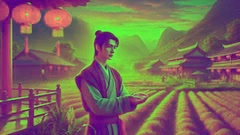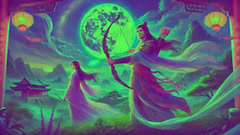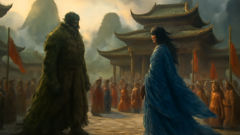Introduction
On clear summer evenings in towns and farmland from the Yellow River to distant coastal isles, people look up and point to two bright stars that keep a promise older than any government, road, or border: Vega and Altair. The ancient Chinese tale of the Cowherd and the Weaver Girl—known in Mandarin as Niulang and Zhinü—has been told, retold, embroidered, and shaped by the hands of storytellers for centuries. This introduction will set the scene: imagine a sky thick with stars, a river of light cutting across it like silk, and a bridge that appears once a year where magpies and cranes gather. Yet, the feeling one takes from the tale—the ache of separation, the joy of reunion, the rituals of remembrance—shifts with each village and valley. In some places the story is a pastoral lament, emphasizing diligent labor and humble loyalty; in others it becomes an elegiac courtship, full of ornaments and palace intrigue. Traders carried versions along caravan routes, fishermen and sailors added sea-sprayed details, and border communities remade names and customs to fit their own seasons and crops. As we travel across regions and across time, we find a single love that branches into dozens of local myths: a tapestry of belief that reflects social values, gender roles, agricultural calendars, and the way different peoples understood the cosmos. The cowherd and the weaver become mirrors for communities to see their own anxieties and hopes. Over the following sections I will guide you through mainland variations, southern and island retellings, cross-cultural connections to Japan and Korea, ritual forms from rice terraces to urban lantern festivals, and modern reinterpretations in literature, film, and public memory—each version showing how a story about two stars adapts to earthbound lives.
Origins and Mainland Variations: From Courtly Romance to Village Lament
Across the great sweep of the Chinese mainland, the core of the Cowherd and Weaver Girl story stays recognizable—two lovers, a celestial separation, and an annual reunion—yet the texture and emphasis shift with culture, geography, and history. In regions that preserved strong ties to imperial centers, the tale often reads like courtly romance. Texts collected in the Tang and Song eras emphasize Zhinü's otherworldly skill at weaving and Niulang's humble honesty. The weaver's loom becomes symbolic of the ordered cosmos: fine threads are fate, patterns mark seasons, and the weaver is intimately tied to heavenly order. In these versions, Zhinü is sometimes portrayed with more autonomy, a maiden whose craft binds the heavens. Details borrow from textile imagery popular among court poets: silk, brocade, shuttle, bobbin. The narrative’s tone leans lyrical, with embellishments that suit literate audiences who relished metaphors and allusions.
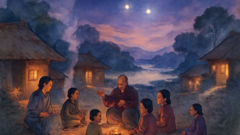
By contrast, in darker or more remote agrarian communities the story is practical and mournful, a folk parable about separation and labor. A northern village that depends on sheep and millet, for instance, frames Niulang as a cowherd whose life is defined by weather and the needs of livestock. The Weaver Girl's leave-taking is read in the context of the seasons: she weaves cloth for the family's warmth, and when she is taken away the household is stripped of comfort. Local narrators emphasize sweat, frost, and scarcity; the conflation of human hardship with cosmic distance makes the reunion all the more desperate. In these variants, the magpie bridge is not only miraculous but communal: entire neighborhoods are said to form the bridge, emphasizing social solidarity and neighbors’ role in bridging loss. Instead of palace intrigue, oral tellings foreground everyday sorrow and the practical acts of remembrance—offering the empty loom bread, hanging threads on doorframes, or lighting small fires to attract protective birds.
Regional rituals grew from these tonal differences. In some northern districts, farmers hold an annual dusk ceremony where young women take out their weaving tools and show their skill, a ritual invocation asking for Zhinü’s blessing on cloth and marriage. Elsewhere, young men might gather at a riverside on the designated night to release small paper boats carrying messages to the stars—requests for rain, fertility, or favor. The story's moral contours shift too: in elite literary circles the emphasis might be on the tragic consequences of divine interference and the sanctity of duty; in peasant tellings the moral often celebrates fidelity in the face of hardship and the communal obligation to help neighbors endure.
Ethnographers and folklorists who traveled through the Jiangnan rice-growing region recorded another twist: here, Zhinü's weaving is linked not only to fabric but to the body of the land. The act of weaving becomes a metaphor for irrigation and the knotted channels that guide water to paddies; the Weaver Girl's absence is echoed in dry irrigation ditches. During late summer, women would sing lullabies at communal weaving sessions that combine practical instruction with reminiscence of the lovers’ separation—songs that double as mnemonic devices for knowing when to transplant rice, when to harvest, when to pray. The tale takes on the rhythms of the agricultural calendar and integrates with local women's labor, turning myth into a living blueprint for seasonal life.
Minor variations accumulate into strikingly different portraits across China's provinces. In the north, where long winters shape local imaginations, the lovers' reunion occurs in a sky sharpened by cold and the bridge of birds is given additional powers: if you bring a handful of steamed wheat to the river's bank and call to the stars, they say the magpies will ferry that grain up as a pledge of annual abundance. In the southwestern highlands, where ethnic minorities preserve distinct languages and shamanic practices, the weaver herself may be portrayed as a mountain spirit who takes a mortal husband. The shamanic version often involves trials by animal allies and symbolic exchanges: Niulang must pass tests given by the river dragon or earn tokens from ancestors to be permitted to climb to the sky. These ritual-rich forms stress transformation and reciprocity with the natural world rather than the polite sadness of court versions.
Literature, unsurprisingly, has both preserved and transformed these forms. Song lyrics and later drama sometimes present the story with refined elegy—the weaver as an emblem of refined virtue, the cowherd as an exemplar of rustic sincerity. During times of political turmoil or migration, the narrative took on the resonance of separated families. Letters from migrants in port towns and frontier markets often included references to the two stars, words meant to comfort distant wives and parents: “We will be like Altair and Vega—part for a season, reunited again.” The story served as a portable grammar of absence and reunion.
Translations and local printings also affected details: as the printing culture spread, woodblock prints pictured Zhinü with more elaborate dress, sometimes borrowing from courtly fashions far from her supposed rural origins. In regions exposed to merchant routes, traders introduced foreign motifs: dragons, certain jewelry shapes, and even foreign textiles that crept into descriptions of the Weaver Girl’s clothes. These visual cues began feeding back into oral performance; once an image appeared in a popular print, storytellers would adopt the new ornamentation into their recitation, and the tale's iconography subtly shifted to align with the tastes of the times.
Finally, the relationship between gender and duty gets revised in different tellings. In conservative rural variants the story can be a cautionary tale about the chaos that ensues when heavenly responsibilities are neglected—Zhinü is punished for staying with a mortal, and Niulang suffers for daring to claim domestic bliss over cosmic order. But in progressive retellings—particularly those that emerged in port cities exposed to modern education in the late 19th and early 20th centuries—the emphasis shifts to mutual sacrifice and the injustice of enforced separation. Modern poets recast the pair as early champions of romantic love, and women's societies used the tale as a rallying metaphor for women's labor and autonomy. Thus, the same two stars reflect the changing values of a civilization: sometimes an emblem of cosmic balance, sometimes a lens into social change, and always a mirror for the human longing to bridge distance.
Across the mainland, then, the Cowherd and Weaver Girl remain at once the same and entirely different: a courtly couple in silk scrolls, an emblem of agricultural fidelity in rice terraces, a mountain spirit and a mortal in ethnic tales, and a symbol of migration in market towns. These differences make the story richer, because each community writes its own needs, rituals, and weather into the narrative, transforming a universal sorrow into local meaning.
Island, Border, and Modern Retellings: How Sea, Trade, and Media Rewove the Myth
Beyond the Chinese heartlands, the Cowherd and Weaver Girl spread like ink on wet cloth—absorbed and remixed by islanders, traders, and border communities who reshaped plot and symbol to fit local cosmology. On coastal islands and among fishing communities, maritime life recast the myth in blue tones. Zhinü occasionally becomes a goddess of nets and sails, her weaving translated into intricate knots that secure boats and masts. Niulang, the earthbound herdsman, might be replaced by a fisherman whose livelihood depends on tides and moon. The river separating the lovers turns into an ocean channel, and the magpie bridge is reimagined as a flock of seabirds, terns or gulls, whose wings lift as one to form a corridor. Local ritual adapts accordingly: fishermen might release linen bundles into the sea as offerings to the stars, or tie strips of woven cloth to the bows of boats to attract protective birds—practices that function both as sympathetic magic for safety and as narrative acts of remembrance.
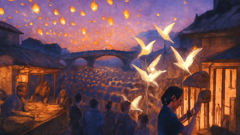
In borderlands where languages and faiths mix, syncretic elements enter the story. Traders from the Silk Road and maritime routes introduced motifs and artifacts that dot local variants. In certain southwestern border communities influenced by Tibetan and Southeast Asian myth, the weaver’s looms are likened to mandalas—symbolic charts of the universe—and Zhinü can be invoked as a cosmic weaver whose patterns bring harmony to human relations. In some places, the cosmic river becomes a spirit-guarded boundary where offerings must be negotiated with local deities. The lovers’ trial evolves: Niulang may be required to perform a task for the local river guardian or to offer a precise number of ritual items to secure a passage once a year. These additions highlight how boundary zones prize negotiated reciprocity with natural and supernatural forces.
Japan and Korea, culturally proximate and historically connected, forged their own versions that are distinctly local. In Japan the festival of Tanabata derives directly from the same origins, reimagined through Heian literature and Japanese aesthetics. The Japanese version foregrounds written wishes tied to bamboo and sometimes emphasizes the lovers' moral characters in ways that intersect with Shinto and courtly ideals. In Korea, the narrative resonates with an emphasis on filial piety and seasonal ritual; local shamanic components can emphasize ancestral mediation. These cross-cultural variants show that while the celestial motif is shared, the social values—marriage systems, gender norms, ritual practices—shape respective tellings.
Colonial and modern media added another layer. Early 20th-century periodicals printed serialized versions of the story that transformed it into contemporary romance, often setting parts of the tale in cityscapes or reimagining the Weaver Girl as a modern woman educated in the classical arts. Films and television in the late 20th and early 21st centuries pushed further: costume dramas lavishly dressed Zhinü in cinematic silks while relocating Niulang to roles as a simple mechanic or a migrant worker, making the story speak to contemporary viewers. Directors sometimes use the Qixi motif to comment on migration, transnational marriage, or the emotional costs of urbanization. Music videos and pop songs distill the story into a refrain of longing, repeating the symbolism of the river and bridge for audiences who may no longer keep looms or herd cattle.
Cities reinvent Qixi as spectacle. Urbanized communities with diasporic populations stage lantern festivals, pop-up markets, and theatrical performances where the magpie bridge is an installation of thousands of paper birds. These public performances act as cultural maintenance: they remind young city dwellers of origins, even as the city version strips away some of the tale’s agrarian specificity. Meanwhile, LGBT and feminist artists have reclaimed the narrative’s themes of separation and reunion to explore alternative intimacies—what does it mean to be forbidden by cosmic order, and how can ritual respond to new forms of love? Contemporary reinterpretations sometimes subvert the original moral architecture, offering endings where the lovers refuse cosmic punishment or where community action dismantles the heavenly decree. These retellings turn myth into a living conversation about justice and personal autonomy.
The tale’s adaptability has also made it an instrument of education and identity for Chinese diasporas. Migrant communities in Southeast Asia—Malaysia, Singapore, the Philippines—preserve Qixi through communal gatherings, matching the celestial calendar to harvests and local lunar traditions. In diasporic temples, the story becomes an anchor for cultural continuity: language classes teach the names Niulang and Zhinü; community centers host weaving workshops that recreate the tactile world of the weaver; youth choirs perform adapted songs blending local instruments with Chinese pentatonic melodies. Such practices transform the myth into a multi-sensory memory palace that migrants use to maintain identity away from ancestral soils.
Oral historians who recorded border and island versions have highlighted small but telling divergences. On an island archipelago, the lover might carry a conch shell instead of a cowherd’s staff; in a border trade town, the Weaver Girl may be depicted as a trader's daughter who learned weaving from foreign wives—her action of leaving the sky is framed not as punishment but as marriage across cultures. These details matter. They show that the narrative’s adaptability is not accidental but emergent: people recast the lovers to reflect their own matrilineal or patrilineal customs, marriage practices, and social priorities.
Finally, in modern scholarship and creative practice, the Cowherd and Weaver Girl functions as a bridge between past and present. Academics trace motif diffusion; novelists post modernize the myth as an allegory for globalization; performance artists use the magpie bridge as a visual metaphor for migration routes. Each retelling continues the story’s ancient promise: that love finds a way to cross the distance, even when the route is rebuilt by different hands. The result is a living corpus of regional variants that, taken together, offer a panoramic view of East Asia’s cultural shifts. The lovers remain two bright stars in the sky, but on earth their story has become many stories—woven, braided, and rewritten by communities who see themselves in the act of separation and the hope of reunion.
Conclusion
The Cowherd and the Weaver Girl survives because it is less a single fixed text than a living pattern in human imagination: a motif travelers carry, villagers adapt, artists reframe, and migrants re-embed in new contexts. Each regional version is a small act of cultural translation, bending the tale to local weather, labor, gender norms, and ritual calendars. The magpie bridge—a simple, striking image—serves as both a narrative pivot and a social project: communities stand together to form the bridge of memory that allows the separated pair to meet. In doing so, they remind themselves how social bonds are made and remade across distance. When festivals call people to rivers and plazas to look up at Vega and Altair, they are not simply retelling an old story: they are renewing social contracts about fidelity, mutual aid, creativity, and the small, persistent hope that separated people might be reunited. For modern readers and listeners, the tale offers both consolation and challenge: it consoles with the promise that bonds can withstand separation, and it challenges us to consider how we might construct new bridges—social, political, and emotional—to address the separations of our time. Ultimately, the Cowherd and Weaver Girl endure because each generation sees in them the reflection of its own skies and its own work—whether the loom, the sea, or the city street—reweaving an ancient promise into forms that speak to the present.



